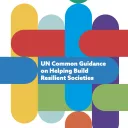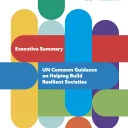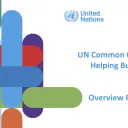The UN Common Guidance on Helping Build Resilient Societies
Learn how to integrate a resilience lens with shared conceptual clarity about what resilience-building really is.
The UN Resilience Guidance was approved by the UNSDG in 2021

of the UN Deputy Secretary General
Ms. Amina J. Mohammed

Introducing the UN Common Guidance on Helping Build Resilient Societies
We need resilient societies now more than ever. Risk has become increasingly interconnected, with the impacts of shocks and disasters cascading across systems and sectors. This requires comprehensive and joined-up efforts to build resilience that can transcend a range of risks, sectors and stakeholders.
Let's build resilient societies
The UN System has a key role as a convener of multiple actors working together to reduce the systemic risks that have become deeply ingrained in the functionality of our societies. This requires bold and transformative action that will bring the world onto a more sustainable path. Resilience is a common thread across the three United Nations pillars of development, human rights, and peace and security. It is also reflected in many important global policy agendas and frameworks that acknowledge that risks and their manifestation can hinder the implementation of the 2030 Agenda for Sustainable Development and the Sustaining Peace Agenda.
The UN Common Guidance on Helping Build Resilient Societies aims to strengthen coherence in UN resilience-building efforts at country level in support of Governments’ sustainable development objectives. It shows a way towards joined-up solutions and collective outcomes that build on the comparative advantages of humanitarian, peace and security, development, and human rights interventions. It also provides a timely reference for the implementation of the UN socio-economic, health and humanitarian response framework to COVID-19 to ensure that a comprehensive and multi-dimensional approach to risk and resilience appropriately informs the ‘new normal’ during and after the COVID crisis. It aims to integrate a resilience lens into the decisions, programmes and interventions and existing UN policy and programming processes at country level, rather than establish new or stand-alone UN policy or action plans for resilience.
The Guidance offers a flexible approach that can be tailored to country contexts and needs. It is not a blueprint but aims to complements ongoing resilience building efforts at country level by helping to address gaps and bottlenecks towards a more comprehensive and joined-up endeavor. It is an operational guidance for practical application at country level that promotes a common understanding of resilience based on shared principles, and unpacks the process for building resilience together for the UN System and its partners, including a rich annex of practical tools and methodologies. The primary audience of the guidance are UN Teams to help them better equip governments at national and subnational levels to lead on resilience-building, by bringing the UN together around a common understanding and operational approach on risk-informed programming across sectors. The Guidance is also a useful reference for government and partners at country, regional and global levels.
The UN Resilience Guidance was approved by the Director’s level interagency drafting team and endorsed by the UN Deputy Secretary General. It has also been endorsed by the UN Sustainable Development Group.




